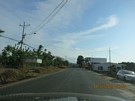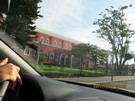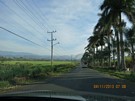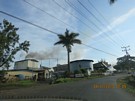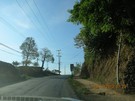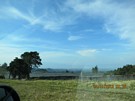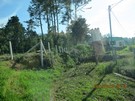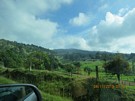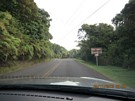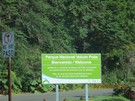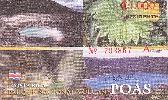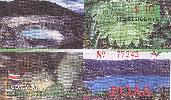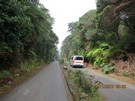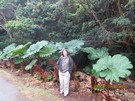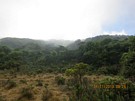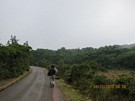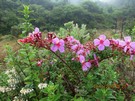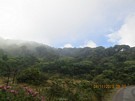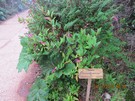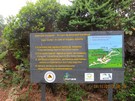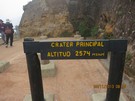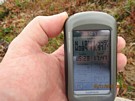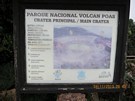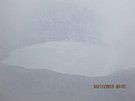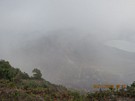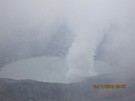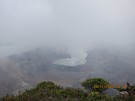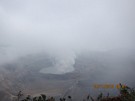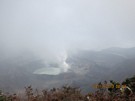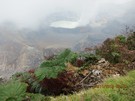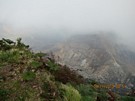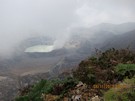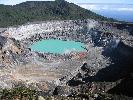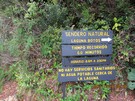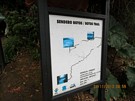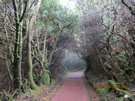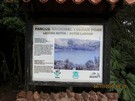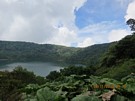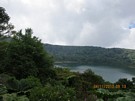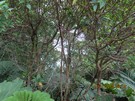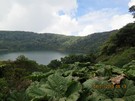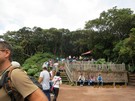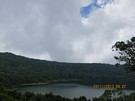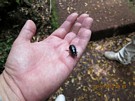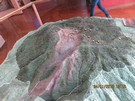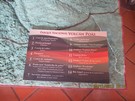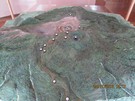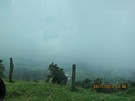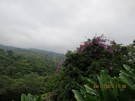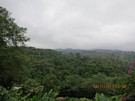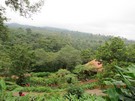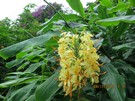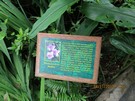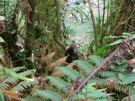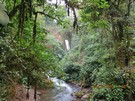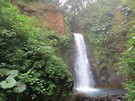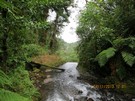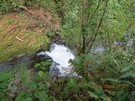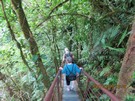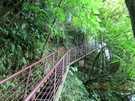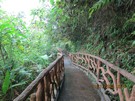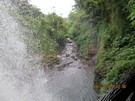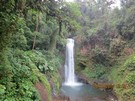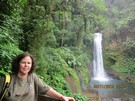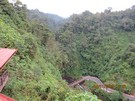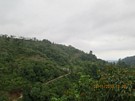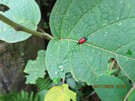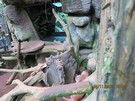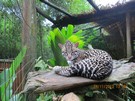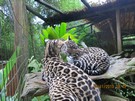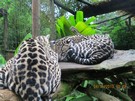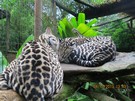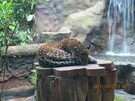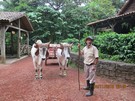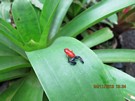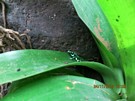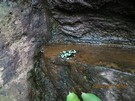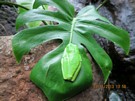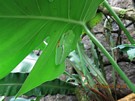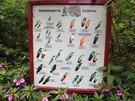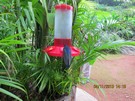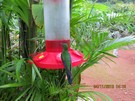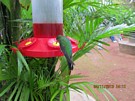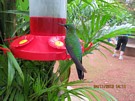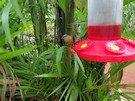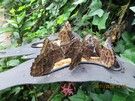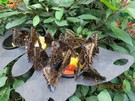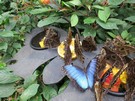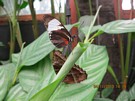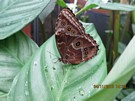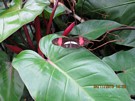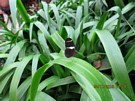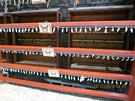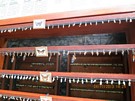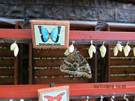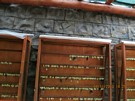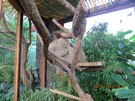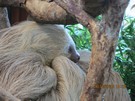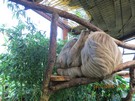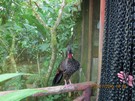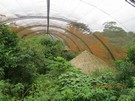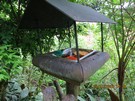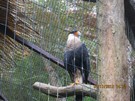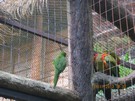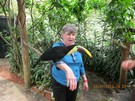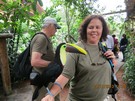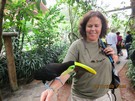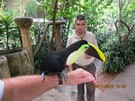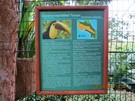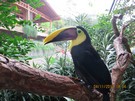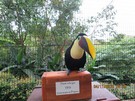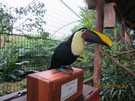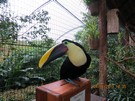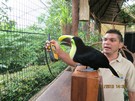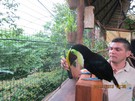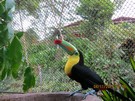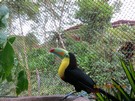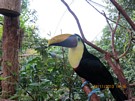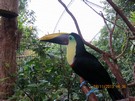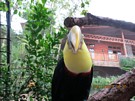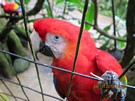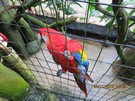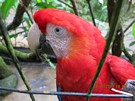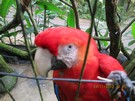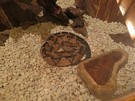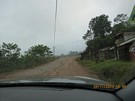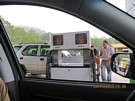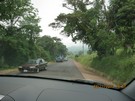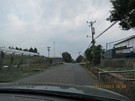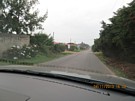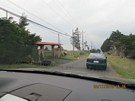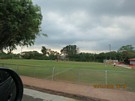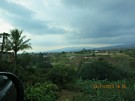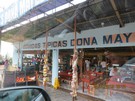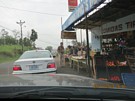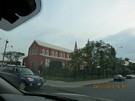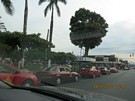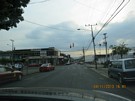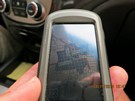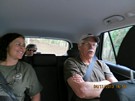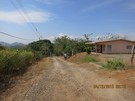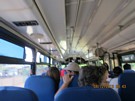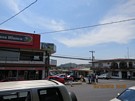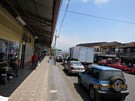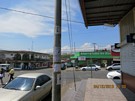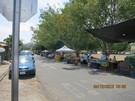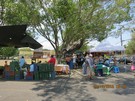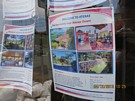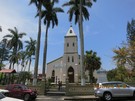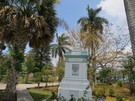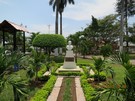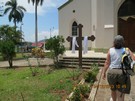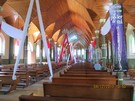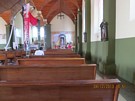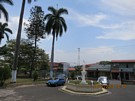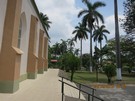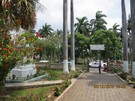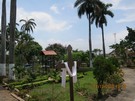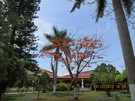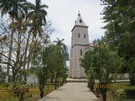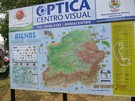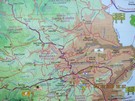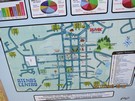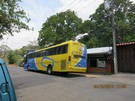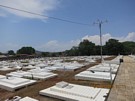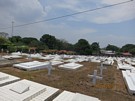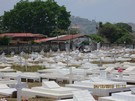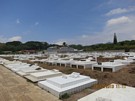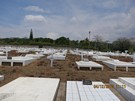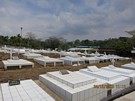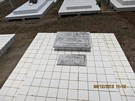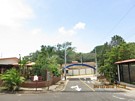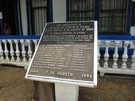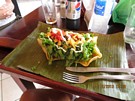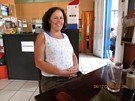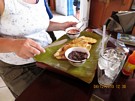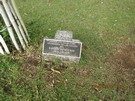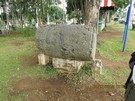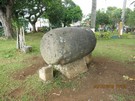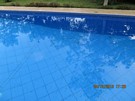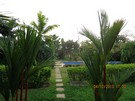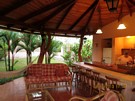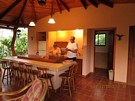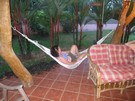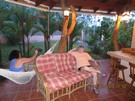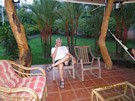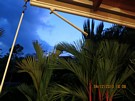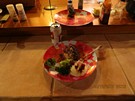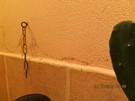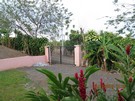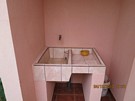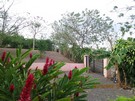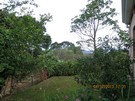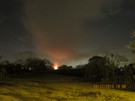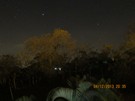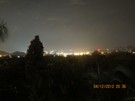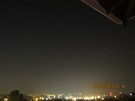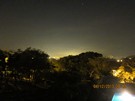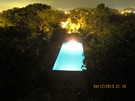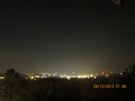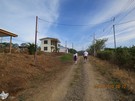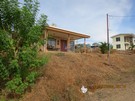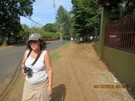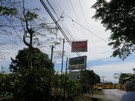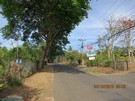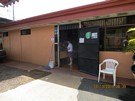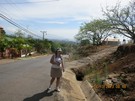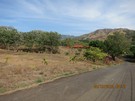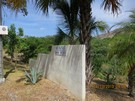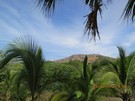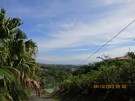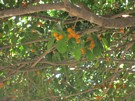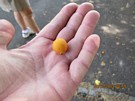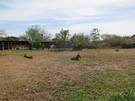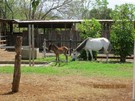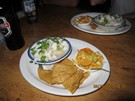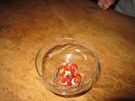Thursday - APR 11 2013
A trip to Poas Volcano
Again, because we did not rent a vehicle on this first trip to Costa Rica we had Marian & Aad Veltman take us on this tour. This was to be a full day. We got an early start as the park opens at 8 and we had to beat the clouds. Generally after noon you can't see anything.
Poas in the distance
The sheet metal church in Grecia built over a 100 years ago.
We were only a few miles from Atenas but since Grecia is at an elevation of just over 3,000 feet its much cooler. The hills above Grecia are lush with coffee plantations. And should you want some sugar in your coffee, you'll be happy to know that sugar cane also grows here.
This perfect combination of altitude and latitude makes for temperate weather conditions, too. The days are warm and mild, the nights are mild, too. Overall, daily temperatures range from 65 to 85 degrees Fahrenheit.
We talked to a number of people during the trip that said it was too cold here to live.
Sugar Cane processing plant
Volcano road sign
Getting higher and the large shaded areas where they grow strawberries
I think this is the town of Cinchona which was destroyed by a earthquake in 2009, which killed 34 people.
Large ferns along the roads
Poas is an active stratovolcano in central Costa Rica. It has erupted 39 times since 1828. There are two crater lakes near its summit. The northern lake, Laguna Caliente ("hot lake"), is one of the world's most acidic lakes, with a pH of almost 0 and little or no aquatic life. Lake Botos, the southern lake, fills an inactive crater and is cold and clear; it is surrounded by a cloud forest within Poas Volcano National Park.
Poas was near the epicenter of a 6.1-magnitude earthquake in January 2009 that killed at least forty people and affected Fraijanes, Vara Blanca, Cinchona (the most affected area), the capital San Jose, and the Central Valley region of Costa Rica. There was also eruptive activity in 2009 involving minor phreatic eruptions and landslides within the northern active crater. Poas eruptions often include geyser-like ejections of crater-lake water.
Welcome to Poas... Please spend money. Funny but true.
We discovered that most places in Costa Rica are dual priced for residences and non-residences. $10 each for gringos. Not sure what
the residence rate is ? 1,000 Colones ($2.50 US)
The paved road that you walk from the parking / visitor center to the volcano
Mary next to Poor man's umbrella
Views along the trail
I love this sign... If you feel bad.... If you can breathe.. don't stay long time....
At the crater 8,413 feet
What it looks like when its clear
So we went for a hike to Lake Botos, the southern lake, fills an inactive crater and is cold and clear; it is surrounded by a cloud
forest within Poas Volcano National Park. The trail was steep and the elevation close to 9,000 feet did not help with hiking. But it
was nice and cool in the upper 50's
Back at the visitor center. The volcano map
Very cloudy on the drive to Lapaz Waterfall Gardens
Lapaz Waterfall Gardens
From their web page: La Paz Waterfall Gardens is the #1 Most Visited Privately Owned Ecological Attraction in Costa Rica featuring the best hiking near San Jose, the most famous waterfalls in Costa Rica, rescued wildlife preserve with over 100 species of animals and an environmental education program
Generally we don't go to places like this but it was very well done. We ate a buffet lunch in Colibries restaurant. It was a typical
Costa Rican fare with North American foods like Pizza.
The cages of local critters were very well maintained.
Like Poas this place had the dual admission prices for locals and the tourists.
The gardens are located along the road from San Jose to San Miguel at 10.2039N 84.1626W. Because its in between two (really 4) volcanos
its cloudy and wet here most of the time from noon on. Because of this it was very comfortable.
Some of the vegetation was marked along the trails
Coati along the trail. They are members of the raccoon family and are the size of a large house cat.
The first waterfall along the trail - Templo Waterfall - 85 feet
Another waterfall along the trail - Magia Blanca Waterfall - 120 feet. Interesting trails and bridges along the way.
The railings were made out of concrete. I assume that wood in this wet environment would not last long.
The road to San Miguel where it crosses below the Encantada Waterfall - 75 feet.
Some type of bug. Probably poisonous because of the color.
So we rode the free shuttle bus back to the main part of Lapaz Waterfall Gardens
Cougar sleeping
Margay's - Tree Ocelot (You had to be very careful as they could grab your hand while taking photos)
Jaguar - The largest and most powerful feline in the Western Hemisphere and # 3 in size after the tiger & lion.
The oxcarts, which once dominated the rural landscape of the central highlands, date back to the end of the 19th century, but were used exclusively to transport coffee and other agricultural products well into the 20th century. The oxcart seems to symbolize the self-reliance and fortitude of the small Costa Rican farmer.
Various local frogs.
Some of the most active hummingbird feeders I have ever seen
More than just hummingbirds
Butterflies on citrus.
Various Butterflies
Butterflies nursery
Sloth - Extant sloths are arboreal (tree dwelling) residents of the jungles of Central and South America, and are known for being
slow-moving, and hence named "sloths". Sloths move only when necessary and even then very slowly (sounds like some of the people I work with)
La Paz has a nice Aviary with many local species that would get quite close.
Judy with her new friend - the Toucan
Mary - This was the #1 bird to see on her list. In a few days we would see them in the wild.
Ken with Chestnut-mandibled Toucan or Swainson's Toucan
On the tip box
Playing with the radio
Cool birds...Keel-billed and Chestnut mandibled toucans.
The finger eaters... Scarlet Macaws. We would see them in the wild at Carara NP
The Central American Bushmaster - Up to 12 feet - The longest venomous snake in the Americas and the largest viper in the world.
In Costa Rica up to 3,250 feet. - Nocturnal but active at dusk. Bites are rare but there is a 75% mortality rate.
They employ the hide and wait strategy on hunting where they will wait up to 25 days for food.
Bushmaster is a deadly snake. It is more than four meters long and is the largest viper in the whole world. Cascabel muta is the scientific name of this creature given by Carolus Linnaeus, the founder of modern biological nomenclature. It means the silent rattle snake. The bushmaster is found in Brazil, Ecuador, Costa Rica, and in different parts of Central America. Researchers from Costa Rica say that the bushmaster from Osa, Costa Rica is more aggressive than others.
We started heading back to Atenas. This was probably the worse road we experienced in Costa Rica. No worse than many roads around home.
Stopped to get gas. They have regular and super. We were told Regular is not good.
Along the road. Not bad.
We stopped at a roadside market (comidas Tipicas Dona Mayela) to get strawberries. Mary and Aad shopping. This market is located at 10.1624N 84.1989W
Back thru Grecia by the metal church. And looking at the GPS. I purchased the Costa Rica module -- Costa Rica GPS Map for Garmin Units (MicroSD Card) and was impressed with it.
Mary, Walt and Judy way in the back.
Friday - APR 12 2013
After Thursdays adventure, today is a take-it-easy day. Walt and Judy are laying low and Mary and I took the public bus to Atenas.
The farmer's market is on Friday morning and we were eager to check it out.
Walking up our dirt road on a sunny morning
Riding the bus. It was not bad and very cheap. It takes you into downtown Atenas. Most people don't have cars here.
Downtown - Looking at the gated expat areas south of town on the hills
Clean and very busy
Farmer's Market
I really wanted to get the feel of the community. So, we sat in the park for a while. It was like we went back in time. We watched a kid playing with a rubber band-powered airplane. People seemed happy and we only had one person ask us for money. The area seemed very safe as we did not feel threatened here at all.
We walked over to the church (Iglesia Catolica de Atenas) and explored the grounds.
Nice map of the local area
We walked over to the big bus station. Amazed at the frequency of the buses to/from San Jose and Alajuela
Went over and checked out the large Cementerio de Atenas (Atenas) which is very obvious when you look at satellite images of the area. On the way back the heat was starting to bother Mary. It was probably in the low 90's
The entrance to a new housing development near town.
Government building
We ate at a restaurant at the northeast corner of the park. It was very good and the food comes on banana leaves.
Large round rocks in the park ?
Pollen in the pool. Not a problem ! (as I type this its 95 today in SE Pennsylvania. I would love to be in that pollen pool) !
Looking back at the pool from the Rancho.
For something fun, we ate dinner at the Rancho down by the pool.
The ants came to dinner too in the sink area
Various property views. The second gate
One of the complaints in the Atenas area (as well as other locations in rural Costa Rica) is that the farmers burn the sugar cane fields. Since our house has no A/C (that works) we were concerned that we could have to close the windows at night. But, we lucked out that the smoke went way above us. Also, I assume that this increased air pollution did not help the debris in the pool issue.
In any case it made the evening exciting.
The city lights behind the fire area are the San Jose metro area
Orion - The three stars. A bit lower here at 9 north
Atenas all lit up. The soccer field is most of the lights. The southern cross in in the view too.
Looking East towards San Jose
The Southern Cross
The pool looking very good !
Its later and less light pollution. Every star in this view can't be seen from the USA
Saturday - APR 13 2013
Another stay-at-home day. Today was the only day we had heavy rain during the day. We ended up taking a taxi to a restaurant a few miles away.
On another walk.
Our Tico neighbors that have the dog that barks all night.
Today we are heading east on our walk on the road to Santa Eulalia. We walked past Iglesia de Santa Eulalia.
El Cafetal Inn. We had hoped that this would be a place to eat a few nights. But, we later found out that its really not in business anymore. Oh well.
Judy buying something at one of the small stores to the east.
Mary walking up the hill. Poas Volcano (left) & Barva Volcano on the horizon.
We walked back the dead-end road to Quintas don Pepe. Very dry.
Some type of citrus tree that seems to be everywhere.
Critters
We took a taxi up to a resturant (Restaurante El Mirador located at 10.0031N 84.3933W) The waiter was having fun practicing english on us and then gave us some local dishes. The food and service was excellent and we will come back here again.
Red sugar toasted peanuts. Have not seen these for years.
